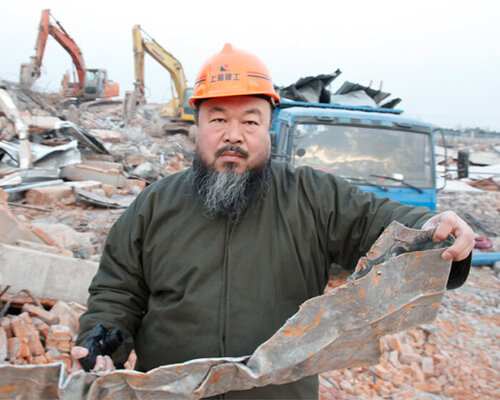AI WEIWEI’S STUDIOS TELL A STORY OF ARTISTIC RESILIENCE
At Berlin’s Aedes Architecture Forum, the exhibition ‘Five Working Spaces’ invites visitors to glimpse into Ai Weiwei’s studios across continents. On the occasion of the opening on May 23, 2025, designboom spoke exclusively with the artist, uncovering how each workspace embodies his political convictions, personal history, and creative vision. A central focus of the exhibition is Ai Weiwei’s most recent studio in Montemor-o-Novo, Portugal, built using traditional Chinese woodworking methods.
‘My studio is an extension of my body and mental state. Of course it’s political. Anyone who sees the exhibition can understand — it’s not that I want it to be political. It just is political,’ Ai Weiwei tells designboom.
all images courtesy of Aedes Architecture Forum and Ai Weiwei Studio, unless stated otherwise
ARTIST, ARCHITECT AND ADVOCAT FOR HUMAN RIGHTS
Rather than illustrating architectural typologies or design processes, ‘Five Working Spaces’ explores Ai Weiwei’s studios as existential conditions, rooted in the artist’s early experiences of political exile. Born in Beijing, Ai Weiwei spent his formative years in remote regions of China, where his father, the poet Ai Qing, had been banished during the Anti-Rightist Movement. Known for his outspoken critique of authoritarian systems and his advocacy for human rights, Ai Weiwei ranks among the most influential figures in contemporary art and activism. His wide-ranging practice — spanning art, architecture, film, and social engagement — merges traditional Chinese craftsmanship with global aesthetics and personal narrative.
Five Working Spaces on view at Aedes Architecture Forum until July 02, 2025 | image © Erik-Jan Ouwerkerk
FIVE WORKING SPACES AT AEDES ARCHITECTURE FORUM IN BERLIN
The exhibition ‘Five Working Spaces’ at Aedes Architecture Forum traces key chapters of the artist’s life through the lens of architecture, presenting five studios located in Beijing, Shanghai, Berlin, and Montemor-o-Novo. Designed, commissioned, and inhabited by Ai Weiwei himself, each workspace mirrors shifting personal and political realities, documented through architectural models, photographs, drawings, and personal texts.
‘What’s similar is that all of them are tied to one individual – me – trying to fit myself into a working condition. But that condition is always changing. It’s more about connecting to my life, to the conditions I was given, the environments I lived in, how I grew up, how I became an architect, how I acted during moments of social and political change,’ he reflects in our conversation.
Ai Weiwei working on still life in his studio, Caochangdi, Beijing, 2000
His first studio in Longzhuashu, Beijing, redefined an austere concrete courtyard with a quiet gesture: planting Danish grass. The transformation was subtle, yet symbolically powerful — an act of reclaiming space through care. In the early 2000s, he designed his compound in the Caochangdi district, also in Beijing, which soon became a hub for artistic collaboration and large-scale installations. Both spaces would later be demolished by authorities, along with others: the Malu Studio near Shanghai in 2011, dismantled shortly after completion, and the Zuoyou Studio in 2018, destroying works still stored inside.
‘I’m used to irrational violence and no explanation. You cannot figure out the logic. You just take it and survive in it,’ the artist recounts, reflecting on these losses. ‘I grew up in that kind of environment. I was born into it. My father was exiled the year I was born. As demonstrated in the exhibition, I lived underground with my father — in a black hole.’
demolition of the Shanghai studio in Malu
In Berlin, Ai Weiwei established a studio in the cellar of a former brewery — an underground, introspective space that resonates with the years he spent in forced exile alongside his father in remote Xinjiang. Tucked away beneath the surface, for the artist, working underground is not only a physical experience, but also an emotional excavation, shaped by reflection and a return to memory.
Speaking to designboom, Ai Weiwei elaborates on this temporal shift: ‘I’m considered a contemporary artist, but my deepest emotions are connected to the past. I’m not familiar with German culture, because I don’t speak the language. I always relate my practice to the past. I appreciate human memory. Without memory, we don’t know who we are or where we come from. Then we can’t appreciate our current condition.’
inside Ai Weiwei’s studio in Berlin, 2018
The most recent of Ai Weiwei’s five working spaces lies in Montemor-o-Novo, a rural town in southern Portugal. The expansive wooden structure draws on traditional Chinese joinery, assembled without nails or screws. Designed with 100 regular columns and a rotated roof that echoes his demolished Malu Studio near Shanghai, the building stands as a monument to craftsmanship and cultural memory. This fifth studio, completed in 2023, resists categorization. Officially registered as a warehouse, it contains no defined program.
‘Architecture is part of our body — our state of mind and physical condition,’ reviewing the decision to settle in Portugal, Ai Weiwei notes a change in pace and outlook. ‘I want a location that’s peaceful and quiet. A place where you can look at the sky and realize there are stars. In the morning, you can see the sun rays. In the evening, the moon comes up. That fits my psychological condition today.’
timberwork of the Portugal studio in Montemor-o-Novo | image © Yanan Li
Ai Weiwei’s Portugal studio in bird perspective
his fifth studio, completed in 2023
Montemor-o-Novo Studio, nine-part representation model | image © Erik-Jan Ouwerkerk
exhibition view | image © Erik-Jan Ouwerkerk
project info:
name: Five Working Spaces
artist: Ai Weiwei | @aiww
location: Aedes Architecture Forum, Berlin, Germany | @aedesberlin
dates: May 24 – July 02, 2025
The post ‘of course it’s political’: ai weiwei on working spaces in response to power, memory, and loss appeared first on designboom | architecture & design magazine.

